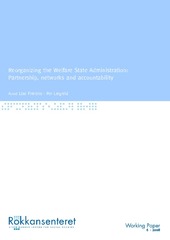| dc.contributor.author | Fimreite, Anne Lise | eng |
| dc.contributor.author | Lægreid, Per | eng |
| dc.date.accessioned | 2010-10-28T08:30:26Z | |
| dc.date.accessioned | 2020-12-10T06:34:14Z | |
| dc.date.available | 2010-10-28T08:30:26Z | |
| dc.date.available | 2020-12-10T06:34:14Z | |
| dc.date.issued | 2008-05 | eng |
| dc.identifier.issn | 1503-0946 | |
| dc.identifier.uri | https://hdl.handle.net/1956/4284 | |
| dc.description | This paper is part of the ongoing evaluation of the reform in the Norwegian employment and welfare administration. The paper is part of working package no 1 in this evaluation named Welfare model, governance system and NAV (the Norwegian acronym for the employment and welfare administration). The paper has been presented at the workshop The shadow line of accountability, performance and control across public private. Venice 17–18 April 2008. | en |
| dc.description.abstract | This paper addresses the big welfare administration reform in Norway. The reform is a merger of the employment and national insurance administrations into a new employment and welfare administration, combined with more formal collaboration between this new administration and the local government social services administration. A central component of the reform is the introduction of a mandatory partnership between central and local government. In this paper we argue that the partnership model chosen is a hybrid of hierarchy and network. A substantial dilemma in the partnership is how to enhance vertical accountability and control within the welfare state administration at the same time as sustaining the autonomy of local government in this policy area. The partnership model created to solve this dilemma represents a delicate and ambiguous balance, a balance first between accountability to the central government and the local council and than between sectorial and territorial specialization. The balance has yet to be tried out in practice. | en_US |
| dc.description.abstract | Dette notatet analyserer NAV-reformen med et særlig fokus på partnerskapsmodellen i reformen. Denne partnerskapsmodellen er et lovpålagt samarbeid mellom de statlige myndighetene innenfor arbeids- og velferdsetaten og de kommunale sosialtjenestene. I dette notatet argumenterer vi for at den valgte partnerskapsmodellen representerer en hybrid organisasjonsform mellom hierarki og nettverk. Et grunnleggende dilemma i partnerskapet er hvordan man kan oppnå vertikalt ansvar og kontroll innenfor arbeids- og velferdsetaten og samtidig vedlikeholde lokal autonomi på dette politikkområdet. Partnerskapsmodellen var ment å håndtere denne delikate balansen mellom hensynet til ministerstyreprinsippet og hensynet til det kommunale selvstyret, men det er mange tvetydigheter i modellen som stiller samspillet mellom vertikal og horisontal samordningen overfor store utfordringer. Det gjenstår å se hvordan partnerskapsmodellen i praksis avveier hensynet til vertikalt ansvar oppover mot sentrale myndigheter og hensynet til ansvar overfor kommunale folkevalgte organ og mellom sektoriell og territoriell spesialisering. | no |
| dc.language.iso | eng | eng |
| dc.publisher | Stein Rokkan Centre for Social Studies | eng |
| dc.relation.ispartofseries | Working Paper | en |
| dc.relation.ispartofseries | 6-2008 | en |
| dc.title | Reorganizing the Welfare State Administration: Partnership, networks and accountability | eng |
| dc.type | Working paper | eng |
| dc.subject.nsi | VDP::Samfunnsvitenskap: 200 | nob |
